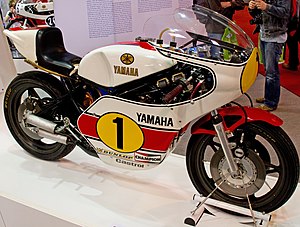Yamaha OW 26
 Yamaha OW 26 (1975) |
|
| Manufacturer | Yamaha engine |
| class | motorcycle |
| Motor data | |
| Two-stroke engine , water-cooled four-cylinder engine, inlet through diaphragm control | |
| Displacement (cm³) | 494 |
| Power (kW / PS ) | 97 hp at 11,000 rpm |
| Top speed ( km / h) | ≥ 280 |
| drive | Chain |
| Empty weight (kg) | 132 |
The Yamaha OW 26 was a racing motorcycle from the Japanese manufacturer Yamaha , which was used in the 1975 motorcycle world championship . With this two-stroke motorcycle, Giacomo Agostini won his last world championship title and Yamaha the first title in the premier class up to 500 cc.
History and technology
In 1971, the development of a half-liter racing machine began under the direction of Takasi Matsui. The design specifications were minimal: the motorcycle should have water cooling, a horizontally split crankcase and disc brakes. Based on the housing of the 250cc engine, the engine of the OW 19 survived the first test run in July 1972. With a bore and stroke of 54 mm and four 34 mm carburetors, it basically corresponded to a double TZ engine . The engine, controlled by a diaphragm inlet and supplied with mixed lubrication , achieved an output of 90 hp at 10,000 rpm, and the curb weight was 145 kg.
1973
The debut in the 1973 season was convincing for the four-cylinder Yamaha in the class up to 500 cc. Works driver Jarno Saarinen won the first two races. In the third round of the world championship, Saarinen fell out with a chain break; in the fourth race Saarinen had a fatal accident in a mass crash in Monza . As a result, Yamaha withdrew from racing until the end of the season.
1974
For the 1974 Grand Prix motorcycle racing season was Giacomo Agostini , who previously factory driver of MV Agusta was and where 13 world titles won, obliged. Teuvo Länsivuori was used as the second driver . The OW 19 was revised in the winter of 1973, six copies of the machine now called OW20 were manufactured and presented to the press. The engine remained technically unchanged except for the changed installation position. However, the chassis has been significantly revised; A cantilever suspension was used for the first time on the rear wheel .
The 1974 season was changeable for Yamaha: two wins and a second place for Agostini, a technical defect (crankshaft damage in France ), a racing failure due to a lack of petrol in Imola , were disappointing in the overall result for the racing team. In addition, the 56th Isle of Man TT and the 38th German Grand Prix were boycotted by the top drivers due to safety deficiencies.
From July 1974 the further development, the OW 23, was used, which was increased in performance (95 hp at 10,500 rpm) and significantly reduced in weight. However, Agostini fell in the eighth race of the season, in Anderstorp , by Barry Sheene ’s cross-standing Suzuki, broke his right collarbone and had to pause for further races; so he was eliminated as hopeful for the title.
1975
The 1975 motorcycle world championship was supposed to be the breakthrough for Yamaha. The 1975 model, which was designated as OW26 , was a slightly revised OW 23 , which was visually almost indistinguishable from this one. Fine adjustments to the carburetor, ignition and a modified resonance chamber reduced the enormous consumption of the engine (up to 22 liters per 100 km) and increased the previously usable speed range of less than 2000 rpm. The better road holding of the Yamaha (due to its chassis) and the best disc brakes of the season are seen as decisive for success over the competition; the engine performance, however, hardly differed from the four-stroke competitor MV Agusta .
With the OW 26 , Agostini won four races in 1975 and came second twice. Three failures, a broken ignition system ( Austria ), engine failure ( Belgium ) and a defective tire on the front wheel ( Sweden ) made the fight for the title between Phil Read and Agostini exciting. Due to the higher number of his victories, Agostini was the first world champion with a two-stroke engine in the premier class; at the same time it was his last title. Yamaha withdrew from the premier class at the end of the season and Agostini drove his penultimate season again for MV Agusta in 1976 .
literature
- Collin MacKellar: Yamaha. All Factory and Production Road-Racing Two-Strokes from 1955 to 1993 . The Crowood Press, 1st edition 1995, ISBN 978-18522-3920-6 .
- Siegfried Rauch: Famous racing motorcycles - 150 old and new racing machines for Grand Prix use . 2nd Edition. Motorbuch Verlag, Stuttgart 1980, ISBN 3-87943-590-1 .
- Volker Rauch: Motorcycle World Championship 75th 1st edition, Motorbuch Verlag, Stuttgart 1975, ISBN 3-87943-389-5 .
Web links
Individual evidence
- ↑ Volker Rauch: Motorcycle World Championship 75, p. 20.
- ↑ Collin MacKellar: Yamaha ., P. 80.
- ↑ Siegfried Rauch: Famous Racing Motorcycles, p. 260.
- ↑ Collin MacKellar: Yamaha ., P. 81.
- ↑ Collin Mackellar: Yamaha , p. 85.
- ↑ MOTORRAD Classic 9/2015, p. 111.
- ↑ Collin Mackellar: Yamaha , p.87..
- ↑ Volker Rauch: Motorcycle World Championship 75, p. 16.

